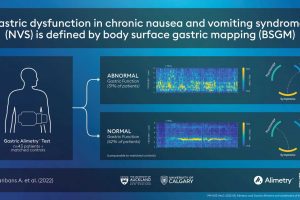Surface mapping a reliable diagnostic tool for gut health


Non-invasive sensors laid on the skin’s surface to measure bioelectrical activity could offer a better alternative for patients suffering with poor gut health.
Stefan Calder, a recent Ph.D. graduate at the Auckland Bioengineering Institute (ABI), at Waipapa Taumata Rau, University of Auckland is the lead and joint-first author for two papers published in prestigious scientific journals this month on gut health. Stefan says gastric disorders are increasingly prevalent in humans, but reliable non-invasive tools to objectively assess gastric function are lacking.
“Many people suffering with chronic gut issues are on a constant diagnostic treadmill of antibiotics or proton pump inhibitors until they are sent for an endoscopy. A reliable surface-based recording could bridge the gap between symptom-based diagnostics and the more invasive minor surgery tests.”
Like the rhythmic beatings of the heart, gut movements depend on bioelectrical activity—but the electrical activity in the gut has been much more difficult to reliably detect. Researchers at ABI and the Faculty of Medical and Health Sciences’ Department of Surgery have employed a novel device using a sticky patch of sensors and a recording device and associated techniques to create a new and reliable non-invasive tool to map electrical waves from the stomach.
Coined “Body Surface Gastric Mapping” (BSGM), the method has proven a reliable detector of gastric slow wave activity and has now led to an exciting and unexpected discovery identifying two distinct disease subgroups in chronic nausea and vomiting syndromes.
The first paper published in The American Journal of Physiology-Gastrointestinal and Liver Physiology, explored the use of the mapping tool in pigs as a pre-clinical study to validate the BSGM prior to advancing to clinical trials in human patients. BSGM has shown to reliably record bio-electrical activity on the gut’s surface and accurately detect changes in both the frequency or rhythm, and direction of electromagnetic waves with intricate detail.
The second paper published in Science Translational Medicine set out to explore the degree of difference in bio-electrical activity between healthy people and patients with chronic nausea and vomiting syndromes defined by the novel gastric mapping device. While previous surgical and non-invasive studies have shown that gastric dysfunctions are associated with abnormal bio-electrical slow waves, the researchers found surprising results.
“Approximately two-thirds of the symptomatic patient group had completely normal bio-electrical activity, while the rest had abnormal activity. We realized there were two sub types of what was previously considered a single disease.
“This may go on to explain or further classify that single disease into two diseases based on different mechanisms. For example, abnormal bioelectrical activity is likely to point to something intrinsically wrong with the stomach itself, but for those patients who show a completely normal slow wave propagation, their issue is likely arising from somewhere else.
“This idea of recording electrical activity on the body’s surface has been around for a long time. ECG machines, recording electrical activity have gained diagnostic acceptance for the last 100 years, but in the gut that is not the case. Through these studies we have validated a device and process that can reliably and accurately evidence bioelectrical activity in the stomach. We also show that bioactivity in the stomach can be a useful biological marker for disease.
“With this bio-electrical information on hand to inform clinical guidance or treatment, people experiencing chronic vomiting or nausea may be directed to different pathways and may receive diagnosis and more appropriate treatment options sooner.”
Associate Director of the Bioengineering Institute, Peng Du says the novel findings and prestigious publications are “a great outcome” and represents decades of research done at ABI and the Faculty of Medical & Health Sciences.
Source: Read Full Article